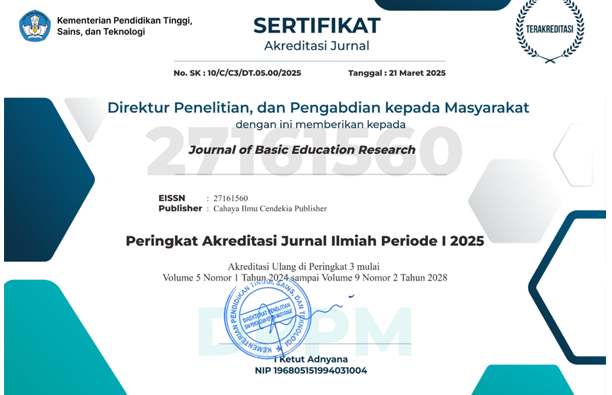Interactive Story for Teaching Ecosystem Topics Using Twine Application for Elementary School Students
Abstract
Purpose of the Study. This study aims to design, develop, and evaluate EcoQuest, an interactive digital story for teaching ecosystem topics to high school students. Utilizing the Twine application, EcoQuest integrates interactive storytelling to create an engaging instructional tool for science education.
Methodology. A descriptive-developmental research design, following the ADDIE model, was employed. EcoQuest was developed using Twine for interactivity, Canva for visual design, and AI-generated narration for audio. Supplementary videos were sourced from YouTube. The tool was evaluated by science education and IT experts using the DepEd Learning Resources Management and Development System (LRMDS) tool and pilot-tested with Grade 6 Elementary student for usability and engagement.
Main Findings. Expert evaluations confirmed that EcoQuest met high instructional and technical quality standards, while student feedback indicated that the interactive format enhanced engagement and ease of use. The study validated EcoQuest as a viable educational tool, demonstrating its potential to support ecosystem instruction in high school science education.
Novelty/Originality of this Study. This study introduces EcoQuest as a localized, interactive, and curriculum-aligned instructional material for teaching ecosystems. Unlike traditional static materials, it employs branching narratives and multimedia elements to foster student engagement. By integrating digital storytelling into science education, EcoQuest provides an innovative approach to enhancing learning experiences in environmental science.
References
C. Uchenna, "Repositioning science education in Nigeria," Global Academic Group, 2025, https://www.globalacademicgroup.com/journals/nard/Chioma
R. J. D. De La Cruz, "Science education in the Philippines," in Science Education in Countries along the Belt & Road, pp. 331–345, 2022. doi: 10.1007/978-981-16-6955-2_20.
A. B. I. Bernardo, M. O. Cordel II, M. O. Calleja, J. M. M. Teves, S. A. Yap, and U. C. Chua, "Profiling low-proficiency science students in the Philippines using machine learning," Humanities and Social Sciences Communications, vol. 10, no. 1, 2023. doi:10.1057/s41599-023-01705-y.
R. Villarino and M. Villarino, "Academic performance of rural junior high school students in biology: Basis for learning activities development," Eurasian Journal of Teacher Education, vol. 2023, no. 1, pp. 1–10, 2025.
I. Ambusaidi, B. Badiali, and K. Alkharousi, "Examining how biology teachers’ pedagogical beliefs shape the implementation of the Omani reform-oriented curriculum," Athens Journal of Education, vol. 8, no. 3, 2021. doi:10.30958/aje.8-3-3.
A. F. Assa, F. J. Rumambi, and C. Wibisono, "Teaching strategy of ecosystems in Jakarta for elementary school students," Utopía Y Praxis Latinoamericana, vol. 26, no. Esp.3, pp. 129–139, 2021.
D. Sahin and R. Yilmaz, "The effect of augmented reality technology on middle school students’ achievements and attitudes towards science education," Computers & Education, vol. 144, p. 103710, 2020. doi:10.1016/j.compedu.2019.103710.
M. Harman, "How interactive storytelling makes eLearning fun," Kitaboo, 2022.
S. Mwelwa and J. Soko, "Storytelling in secondary biology classrooms for enhanced understanding: A case of Kitwe district," 2020.
M. I. Bocharov, T. N. Mozharova, E. V. Soboleva, and T. N. Suvorova, "Development of a personalized model of teaching mathematics by means of interactive novels to improve the quality of pupils’ educational results," Perspectives of Science and Education, vol. 53, no. 5, pp. 306–322, 2021. doi:10.32744/pse.2021.5.21.
M. Černý, K. Kalmárová, M. Martonová, P. Mazáčová, P. Škyřík, J. Štěpánek, and J. Vokřál, "Nonlinear interactive stories as an educational resource," Education Sciences, vol. 13, no. 1, 2022. doi: 10.3390/educsci13010040.
S. Ferns, "Digital/Interactive Storytelling for Education: Using Twine," Ecampus Ontario, 2020.
R. Nohria, J. Kang, and J. M. Belen, "Reflection on the development of a patient case in Twine," Currents in Pharmacy Teaching and Learning, vol. 13, no. 12, p. 1705, 2021. doi: 10.1016/j.cptl.2021.09.039.
H. Husna, S. Nerita, and E. Safitri, "Analysis Of Student Difficulties In Learning Biology," ResearchGate, 2023.
T. Thompson, "Choose your murder: Non-linear narratives enhance student understanding in forensic science education," Forensic Science International: Synergy, vol. 2, pp. 82–85, 2020. doi:10.1016/j.fsisyn.2020.01.009.
D. J. H. Smeets and M. van Dijk, "Interactive storytelling in education: Enhancing critical thinking through narrative branching," Journal of Educational Technology & Society, vol. 23, no. 2, pp. 56–68, 2020.
G. J. Hwang, S. Y. Wang, and C. L. Lai, "Effects of digital game-based learning on students’ science learning engagement and achievement," Interactive Learning Environments, vol. 26, no. 2, pp. 227–240, 2018. doi:10.1080/10494820.2017.1287124.
C. Y. Chang, C. Y. Tsai, and H. K. Lee, "The impact of digital storytelling on students’ scientific literacy and environmental awareness," Educational Technology & Society, vol. 24, no. 3, pp. 89–101, 2021.
G. Gay, Culturally Responsive Teaching: Theory, Research, and Practice. New York, NY, USA: Teachers College Press, 2018.
N. Lasala Jr, "Development and validation of E-SelfIMo: E-learning self-directed interactive module in Earth Science," Recoletos Multidisciplinary Research Journal, vol. 11, no. 1, pp. 85–101, 2023. doi: 10.32871/rmrj2311.01.07.
R. C. Richey and J. D. Klein, Design and Development Research: Methods, Strategies, and Issues. New York, NY, USA: Routledge, 2007.
B. Seels and R. C. Richey, Instructional Technology: The Definition and Domains of the Field. Washington, DC, USA: Association for Educational Communications and Technology, 1994.
R. M. Branch, Instructional Design: The ADDIE Approach. Boston, MA, USA: Springer Science & Business Media, 2009.
M. Molenda, "In search of the elusive ADDIE model," Performance Improvement, vol. 54, no. 2, pp. 40–42, 2015. doi:org/10.1002/pfi.21461.
G. A. Johanson and G. P. Brooks, "Initial scale development: Sample size for pilot studies," Educational and Psychological Measurement, vol. 70, no. 3, pp. 394–400, 2010. doi:10.1177/0013164409355692
M. R. Lynn, "Determination and quantification of content validity," Nursing Research, vol. 35, no. 6, pp. 382–385, 1986. doi:10.1097/00006199-198611000-00017
M. Gallagher, S. L. Haywood, M. W. Jones, and S. Milne, "Negotiating informed consent with children in school-based research: A critical review," Children & Society, vol. 24, no. 6, pp. 471–482, 2010. doi:10.1111/j.1099-0860.2010.00249.x
P. Alderson and V. Morrow, The Ethics of Research with Children and Young People: A Practical Handbook. Sage Publications, 2020.
S. Livingstone and M. Stoilova, "Data and privacy literacy: Educating children and young people in digital societies," in The Handbook of Media Education Research, J. Bulger, P. Davison, M. K. Ito, and A. S. Livingstone, Eds. Wiley-Blackwell, 2021, pp.325–337. doi: 10.1002/9781119166900.ch20
C. S. Dweck, Mindset: The New Psychology of Success. Random House, 2006.
N. L. Lasala Jr, "Validation of game-based activities in teaching Grade 7-Biology," Jurnal Pendidikan IPA Indonesia, vol. 11, no. 4, pp. 519–530, 2022. doi:10.15294/jpii.v11i4.37863
G. R. Morrison, S. M. Ross, H. K. Kalman, and J. E. Kemp, Designing Effective Instruction, 8th ed. Hoboken, NJ: Wiley, 2019.
R. E. Mayer, Multimedia Learning, 3rd ed. Cambridge: Cambridge University Press, 2021.
R. C. Clark and R. E. Mayer, e-Learning and the Science of Instruction: Proven Guidelines for Consumers and Designers of Multimedia Learning, 4th ed. Hoboken, NJ: Wiley, 2016. doi:10.1002/9781119239086
C. M. Reigeluth and A. A. Carr-Chellman, Instructional-Design Theories and Models: Building a Common Knowledge Base, vol. III. New York: Routledge, 2009. doi:10.4324/9780203872130
R. M. Gagné, W. W. Wager, K. C. Golas, and J. M. Keller, Principles of Instructional Design, 5th ed. Belmont, CA: Wadsworth/Thomson Learning, 2005.
R. E. Mayer, Multimedia Learning, 3rd ed. Cambridge: Cambridge University Press, 2021.
J. W. Creswell and J. D. Creswell, Research Design: Qualitative, Quantitative, and Mixed Methods Approaches, 5th ed. Thousand Oaks, CA: Sage Publications, 2018.
M. L. McHugh, "Interrater reliability: The kappa statistic," Biochemia Medica, vol. 22, no. 3, pp. 276–282, 2012.
J. R. Landis and G. G. Koch, "The measurement of observer agreement for categorical data," Biometrics, vol. 33, no. 1, pp. 159–174, 1977.
M. Q. Patton, Qualitative Research and Evaluation Methods, 4th ed. Thousand Oaks, CA: Sage Publications, 2015.
R. J. D. De La Cruz, "Science education in the Philippines," in Science Education in Countries Along the Belt & Road, B. Fan and Z. Wang, Eds. Singapore: Springer, 2022, pp. 331–345. doi:10.1007/978-981-16-6955-2_20
D. W. Massaro, "Multimodal learning: Effects of technology on learning," Educational Technology & Society, vol. 15, no. 2, pp. 22–30, 2012.
N. Lasala Jr, J. Prado, N. Doringo, and J. Ricafort, "BEsMART: Board Examinations Mobile Application Reviewer for Pre-Service Science Teachers using Space Repetition and Hypercorrection," Pakistan Journal of Life and Social Sciences, vol. 23, no. 1, pp. 7274–7290, 2025. doi:10.57239/PJLSS-2025-23.1.00564.
D. Sahin and R. Yilmaz, "The effect of augmented reality technology on middle school students’ achievements and attitudes towards science education," Computers & Education, vol. 144, p. 103710, 2020. doi: 10.1016/j.compedu.2019.103710.
G. Shabiralyani, K. S. Hasan, N. Hamad, and N. Iqbal, "Impact of visual aids in enhancing the learning process: Case research: District Dera Ghazi Khan," Journal of Education and Practice, vol. 6, no. 19, pp. 226–233, 2015.
A. Insorio and D. Macandog, "Video Lessons Via Youtube Channel as Mathematics Interventions in Modular Distance Learning," ResearchGate, 2022.
J. Gray and M. Diloreto, "The effects of student engagement, student satisfaction, and perceived learning in online learning environments," NCPEA International Journal of Educational Leadership Preparation, vol. 11, no. 1, 2016.
I. Ambusaidi, B. Badiali, and K. Alkharousi, "Examining how biology teachers’ pedagogical beliefs shape the implementation of the Omani reform-oriented curriculum," Athens Journal of Education, vol. 8, no. 3, pp. 245–258, 2021.
M. Carmichael, A.-K. Reid, and J. Karpicke, "Assessing the impact of educational video on student engagement, critical thinking, and learning: The current state of play," SAGE Open, vol. 13, no. 1, 2023. doi: 10.1177/21582440231168693.
C. Medupin, "Perspectives on using storytelling as a means of teaching and learning," Education Sciences, vol. 14, no. 1, p. 18, 2024. doi:10.3390/educsci14010018.
C. Medupin, "Perspectives on using storytelling as a means of teaching and learning," Education Sciences, vol. 14, no. 1, p. 18, 2024. doi: 10.3390/educsci14010018.
J. Filgona, J. Sakiyo, D. M. Gwany, and A. U. Okoronka, "Motivation in learning," Asian Journal of Education and Social Studies, vol. 10, no. 4, pp. 16–37, 2020. doi:10.9734/ajess/2020/v10i430273.
H. Husna, S. Nerita, and E. Safitri, "Analysis of student difficulties in learning biology," Journal of Biology Education Research, vol. 4, no. 1, pp. 1–8, 2023. doi:10.55215/jber.v4i1.5963.
M. Carmichael, A.-K. Reid, and J. Karpicke, "Assessing the impact of educational video on student engagement, critical thinking, and learning," SAGE Open, 2022. doi:10.1177/21582440221079886.
Y. T. C. Yang and W. C. I. Wu, "Digital storytelling for enhancing student academic achievement, critical thinking, and learning motivation: A year-long experimental study," Computers & Education, vol. 59, no. 2, pp. 339–352, 2012. doi:10.1016/j.compedu.2011.12.012
C. M. Hung, G. J. Hwang, and I. Huang, "A project-based digital storytelling approach for improving students' learning motivation, problem-solving competence and learning achievement," Educational Technology & Society, vol. 15, no. 4, pp. 368–379, 2012. doi:jeductechsoci.15.4.368.
S. Vishnupriya and R. Bharathi, "Impact of audio-visual aids in teaching," International Journal of Health Sciences, 2022. doi:10.53730/ijhs.v6nS2.8152.
S. Aloraini, "Influence of interactive learning tools on student engagement in online courses in Tanzania," American Journal of Online and Distance Learning, vol. 6, no. 2, pp. 47–57, 2022. doi:10.5430/ajodl.v6n2p47.
Y.-T. Sung, K.-E. Chang, and T.-C. Liu, "Effects of varied multimedia animations in digital storybooks: A comparative study," British Journal of Educational Technology, vol. 51, no. 3, pp. 905–919, 2020. doi:10.1111/bjet.12892.
A. García, F. M. Abad, and I. Calvo, "Use of interactive storytelling trailers to engage students in an online environment," Active Learning in Higher Education, 2022. doi:10.1177/14697874221076125.
M. T. Alshammari, R. Anane, and R. J. Hendley, "Adaptive e-learning environment based on learning styles and its impact on development of students' cognitive skills," International Journal of Educational Technology in Higher Education, vol. 18, no. 1, pp. 1–24, 2021. doi:10.1186/s41239-021-00260-3.
O. D. Göksün and G. Gürsoy, "Digital storytelling in science teacher education: The relationship between self-efficacy and motivation," Science Education International, vol. 33, no. 2, pp. 253–262, 2021.
R. J. Gestiada, F. J. Tisoy, and N. J. Lasala, "The 360˚ view: Contextualized virtual reality tours as innovative teaching tool in ecology for elementary school students," Journal of Basic Education Research, vol. 6, no. 1, pp. 23–36, 2025. doi:10.37251/jber.v6i1.1213.
E. Popescu, "Adaptation provisioning with respect to learning styles in a web-based educational system: An experimental study," Journal of Computer Assisted Learning, vol. 26, no. 4, pp. 243–257, 2010. doi:10.1111/j.1365-2729.2010.00364.x.
Copyright (c) 2025 Joyce Maan Loberes, Ana Carmella Jalmasco, Nestor Jr Lasala

This work is licensed under a Creative Commons Attribution 4.0 International License.
Authors who publish with this journal agree to the following terms:
- Authors retain copyright and acknowledge that the Journal of Basic Education Research is the first publisher licensed under a Creative Commons Attribution 4.0 International License.
- Authors are able to enter into separate, additional contractual arrangements for the non-exclusive distribution of the journal's published version of the work (e.g., post it to an institutional repository or publish it in a book), with an acknowledgment of its initial publication in this journal.
- Authors are permitted and encouraged to post their work online (e.g., in institutional repositories or on their website) prior to and during the submission process, as it can lead to productive exchanges and earlier and greater citation of published work.





.png)


.png)
.png)


















